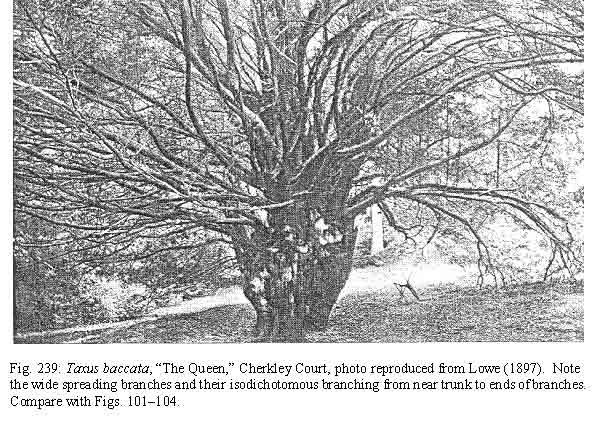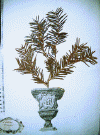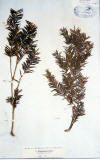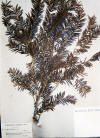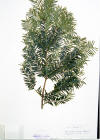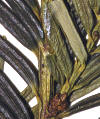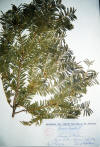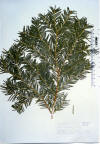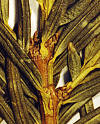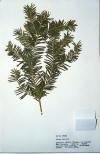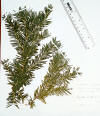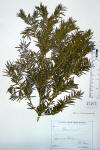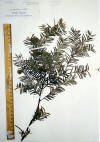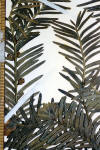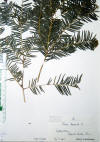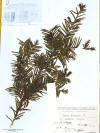|
1a. Taxus baccata L., ., Sp. Pl. 1040. 1753; “Foliis approximatis”; “Europa, Canada”; Hort. Cliff. 464 (1738). Sp. Pl. 1040 (1753). Lectotype designated by Jonsell & Jarvis (Jarvis et al. 1993); Clifford Herb. 464, Taxus No. 1 (BM!, photo at right) undoubtedly from Europe, with mature male cones, leaves densely papillose across abaxial surface, mamillose along margins and on adaxial surface; stomata 8–10 rows per band (as seen under ~60× stereo-magnification). 1a. Taxus baccata var. baccata. European yew. Distribution: widely distributed in the Euro-Mediterranean. Mostly understory trees in hardwood deciduous forest, or coniferous forests, with horizontal branches, and gallish leaf buds (due to the yew artichoke gall, Taxomyia taxi). Branchlets dividing equally, yellowish green when young, reddish orange in age; persistent bud-scales brownish red or chocolate brown, 0.5–1.5 (- 2.0) mm long, thick, turgid, imbricate in 2–3 (-4) seriate, the basal scales adnate, ovate, obtuse, slightly concave, increasingly incurved towards apex along midnerve, smooth or sometimes carinate near apex, the upper-most scales spreading, more strongly concave and incurved, broadly cucullate, otherwise similar to those on underside of branchlet. Leaves spreading along two opposite sides of a branchlet in a flat spray (two-ranked), the margins of adjacent leaves closely parallel and mostly not overlapping, linear, straight to falcate, 1.7–2.2 cm long, 1.5–2.5 mm wide, (resinous) dark green above, olive green below, plane on upper surface to a rounded midrib and rounded margins, plane below to a flush midrib, abruptly recurved near margins (80–90ş), or not recurved; upper epidermal cells elliptical in transverse section, 8–12 µm tall and 10–25 µm wide, similar along ventral margins and midrib; stomata bands and adjacent cells papillose to within 4–8 cells of margins, without stomata on 2–22 rows of papillose cells; papillae usually distinct, covering each cell in the marginal zone, often in two opposite rows; stomata usually (7-) 8–10 (-11) rows in olive green bands; palisade parenchyma most often of 1 row of linear cells, 50–70 µm long; spongy parenchyma cells usually spherical with a granular chloroplast, not falling apart when sectioned. Male cones maturing on 1st yr twigs, in terminal to basal aggregates. Female cones maturing on 1st and/or 2 nd yr branchlets, often solitary; seed in two specimens subglobose to subcylindric, reddish purple, to 6 mm long, 5 mm diam, in one specimen depressed globose, wider than tall, green in color. The European yew is recognized by branches that repeatedly divide into branches of equal length (isodichotomous), and by leaves spreading mostly parallel to one another along two sides of a branchlet, often diverging not more than 70°, scarcely overlapping to slightly crisscrossing when pressed. This variety occurs primarily in the mountains of the Mediterranean Region, but also at lower elevations further north. Its branching and leaf arrangement are characteristics of an understory tree in mixed conifer and deciduous forests. The extent to which T. baccata and its varieties are cultivated in North America needs study. Chadwick and Keen (1976) mentioned 13 cultivars of T. baccata in the Secrest Arboretum; nine of which I recognize as related to natural occurring varieties in the Euro-Mediterranean. Although I have not been able to study all T. baccata these authors listed as cultivars in the Secrest Arboretum, I refer 'Adpressa' to T. canadensis (except for identification of one specimen); 'Nigra' and 'Erecta' and 'Washingtonii' to T. recurvata; 'Fastigiata Aurea' to T. fastigiata;' and 'Dovastoniana', 'Glauca', and 'Repandens', to T. baccata.
|
| Representative Specimens—Algeria: Cedrus forest, 1900–1950 m, Davis 52628 (BM). Morocco: Haout 938 (BM); Ifrane at Cascada, 1580 m, Davis 55121 (BM); Ifrane, 1400 m, Lewalle 8670 (BM). Portugal: Ser. Gerez, Vidoal, Moller (BM). Spain: Barcelona, pare de la Bonanova, Sennen 7087 (PH, not BM); Ser. Tejeda, Modesto Laza Palacios (K); Ser. Buenia, Rodriquez (K); Ser. Cazoria, Yedra, Heywood & Davis 490 (BM); 900 m, Roivainen (S: C-2075). England: Nottinghamshire Bowden & Hillman 433 (BM); Box Hill, Druids Grove, Brubaker 1960 (PH). Germany: Bavaria, Lyck, Milchbuder (K). Hungary: 445 m, Schönach 3084 (BM, two specimens on right, of three). Bosnia: Curic 1897 (K). Italy: Solla (US: 280040); Lagodi Garden, Riva, Sydtyrolen Lenander 1933 (S: C-2008). Austria: Tirol (US: 347988, top right). Montenegro [Yugoslavia: Serbia]: Rohlena 1908 (BM: 17197). Turkey: Taurus, Balansa (BM); Cilicicum in Tauri Alpes, Bulgar Dagh, in rupestribus fanicum opacarum deuexis, prope angustias Agatsche kisse et Gaensin pagi versus Tesbi Seki vallem, 4000 ped., 23 Sep 1853, Kotschy (P). Azerbaijan—Caucasas Mts.: Chanlar, 1800 m, Goghika (NA). |
